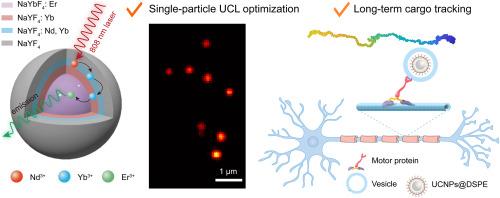808 nm-excited upconversion single-particle imaging for long-term tracking of cargo transport in live neurons
IF 3.6
3区 物理与天体物理
Q2 OPTICS
引用次数: 0
Abstract
Upconversion nanoparticles (UCNPs) activated by 808 nm excitation hold promise for bioimaging due to minimized water absorption and tissue heating. However, their luminescence efficiency and single-particle performance in complex biological systems remain limited. Here, we present a rationally designed core-multishell UCNP structure (NaYbF4: x%Er@NaYF4: y%Yb@NaYF4: z%Nd, 10 %Yb@NaYF4) optimized for enhanced upconversion luminescence (UCL) at the single-particle level under 808 nm excitation. By systematically tuning Er3+ concentration in the emissive core, Yb3+ in the energy migration shell, and Nd3+ in the energy-harvesting layers, we achieved efficient energy spatial management. Single-particle analysis revealed power-dependent UCL saturation, with 12 % Er3+ doping in the core, 10 % Yb3+ doping in the migration shell, and 30 % Nd3+ doping in the energy-harvesting layer yielding maximal brightness. These UCNPs were further surface-functionalized for live-cell imaging and enabled continuous cargo tracking in hippocampal neurons for over 30 min under 808 nm excitation. Trajectory analysis revealed hitchhiking-like transport dynamics within axons. This work highlights the potential of UCNPs for advanced biological imaging and mechanistic insights into nanoscale cargo dynamics in neurons.

808纳米激发上转换单粒子成像用于活神经元货物运输的长期跟踪
808 nm激发激活的上转换纳米颗粒(UCNPs)由于吸水和组织加热最小化,有望用于生物成像。然而,它们在复杂生物系统中的发光效率和单粒子性能仍然有限。在这里,我们提出了一个合理设计的核心-多壳UCNP结构(NaYbF4: x%Er@NaYF4: y%Yb@NaYF4: z%Nd, 10% Yb@NaYF4),优化了808 nm激发下单粒子水平上转换发光(UCL)的增强。通过系统地调整发射核中的Er3+、能量迁移壳中的Yb3+和能量收集层中的Nd3+浓度,实现了高效的能量空间管理。单粒子分析揭示了功率依赖的UCL饱和,在核心中掺杂12%的Er3+,在迁移壳中掺杂10%的Yb3+,在能量收集层中掺杂30%的Nd3+,产生最大的亮度。这些UCNPs被进一步表面功能化,用于活细胞成像,并在808 nm激发下在海马神经元中连续追踪货物超过30分钟。轨迹分析揭示了轴突内类似搭便车的传输动力学。这项工作强调了UCNPs在先进生物成像和神经元纳米级货物动力学机制方面的潜力。
本文章由计算机程序翻译,如有差异,请以英文原文为准。
求助全文
约1分钟内获得全文
求助全文
来源期刊

Journal of Luminescence
物理-光学
CiteScore
6.70
自引率
13.90%
发文量
850
审稿时长
3.8 months
期刊介绍:
The purpose of the Journal of Luminescence is to provide a means of communication between scientists in different disciplines who share a common interest in the electronic excited states of molecular, ionic and covalent systems, whether crystalline, amorphous, or liquid.
We invite original papers and reviews on such subjects as: exciton and polariton dynamics, dynamics of localized excited states, energy and charge transport in ordered and disordered systems, radiative and non-radiative recombination, relaxation processes, vibronic interactions in electronic excited states, photochemistry in condensed systems, excited state resonance, double resonance, spin dynamics, selective excitation spectroscopy, hole burning, coherent processes in excited states, (e.g. coherent optical transients, photon echoes, transient gratings), multiphoton processes, optical bistability, photochromism, and new techniques for the study of excited states. This list is not intended to be exhaustive. Papers in the traditional areas of optical spectroscopy (absorption, MCD, luminescence, Raman scattering) are welcome. Papers on applications (phosphors, scintillators, electro- and cathodo-luminescence, radiography, bioimaging, solar energy, energy conversion, etc.) are also welcome if they present results of scientific, rather than only technological interest. However, papers containing purely theoretical results, not related to phenomena in the excited states, as well as papers using luminescence spectroscopy to perform routine analytical chemistry or biochemistry procedures, are outside the scope of the journal. Some exceptions will be possible at the discretion of the editors.
 求助内容:
求助内容: 应助结果提醒方式:
应助结果提醒方式:


